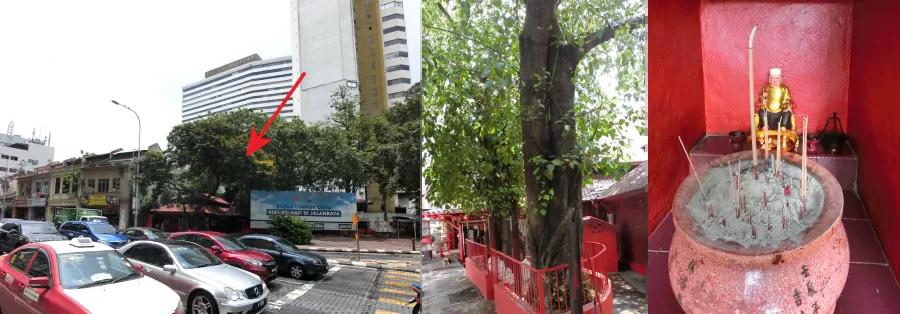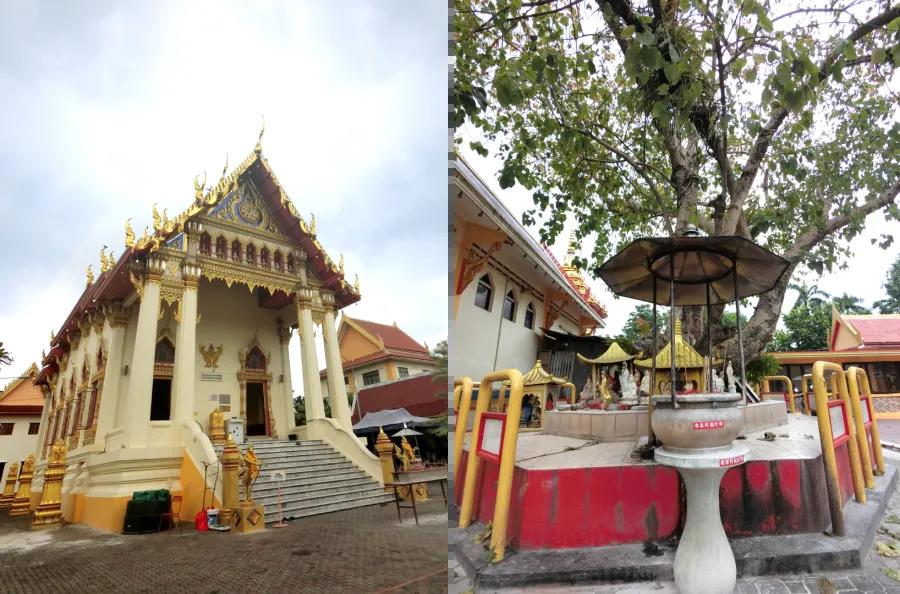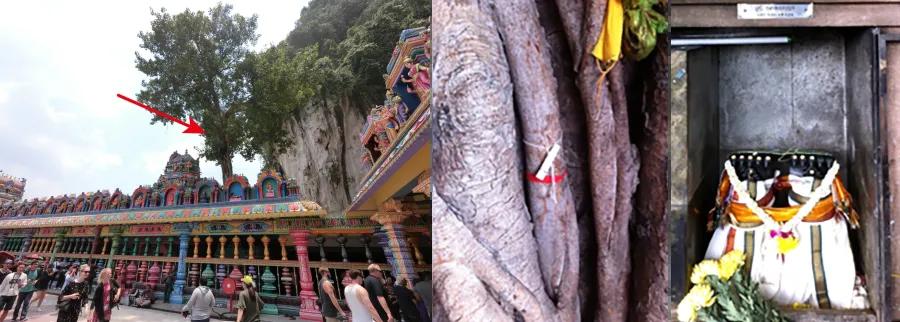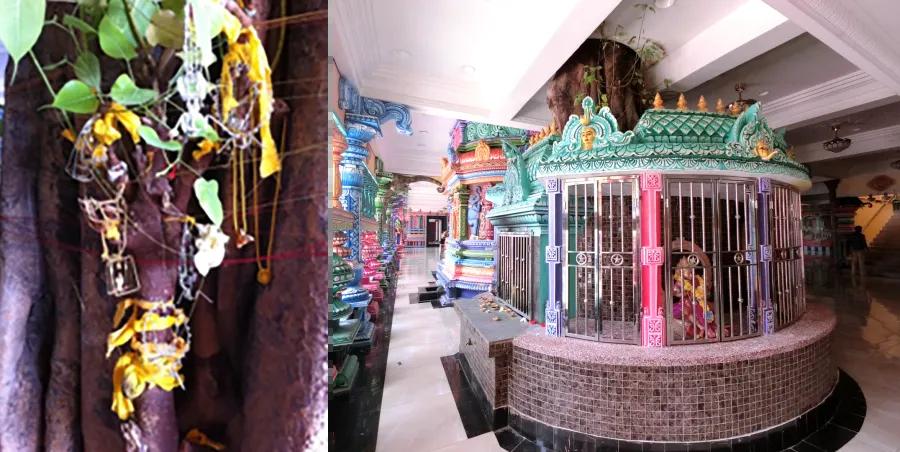Exploring Animism Beliefs and Tree Worship
A small-scale qualitative research project was conducted in the Klang Valley region to gain insights into Malaysian animism. Field observations were made at three famous temples:
- Ipoh Road Chinese Temple,
- Wat Chetawan (a Thai Buddhist temple)
- Sri Subramaniam Hindus Temple in Batu Cave.
In-depth interviews were conducted with relevant individuals, including temple committee members and guardians.
Field Observation 1: Ipoh Road Chinese Temple

The Ipoh Road Chinese Temple, famous among the Chinese community in Kuala Lumpur, blends Sufism and Chinese folk religion. According to the interview, the temple has a significant mythology incident associated with the belief that the spirit of the "Datuk Keramat" resides in a tree near the temple. The tree has been worshipped by the society since 1977, and its supposed indestructible power prevented the temple from being demolished during the construction of a flyover. The worshippers seek protection, good health, luck, and prosperity from "Datuk Keramat." The temple's myth and the power of "Datuk Keramat" have instilled trust within the society residing along Ipoh Road, reinforcing their belief in animism.
Furthermore, the temple's indestructibility against the governing council's efforts has further solidified the trust placed in it by the community. The Sufism Temple on Ipoh Road is a testament to the enduring myths and the supreme power of "Datuk Keramat." The temple's legendary incidents and invincibility have forged a strong bond of trust between the surrounding community and their spiritual beliefs. The fusion of Sufi Saint worship and Chinese folk religion has created a unique religious site that continues to captivate and inspire worshippers seeking divine intervention and blessings.
Field Observation 2: Wat Chetawan

At Wat Chetawan, a Thai Buddhist temple, a worship tree known as the Bodhi tree holds significance in animism belief. The Bodhi tree is believed to possess supernatural power that calms the minds of devotees during meditation and provides solutions to their life problems. The Bodhi tree has long been a symbol of enlightenment in Buddhism, even before Prince Siddhartha Gautama attained enlightenment beneath its leaves in 528 B.C.
Its name, Bodhi, means "awakening," highlighting its spiritual significance. The tree is scientifically known as ficus religiosa, which translates to "religious fig," further emphasising its spiritual associations. In India, the Bodhi tree is considered sacred and highly revered in Bodhgaya, where it is believed that the descendant of the original tree still grows, bearing witness to the Buddha's spiritual awakening.
Interestingly, the symbolism of the Bodhi tree predates the advent of Buddhism. It is also associated with Vishnu, a prominent Hindu god known as the sustainer of the universe. Vishnu, Brahma and Shiva are part of the holy trinity, forming the divine triad. This connection illustrates the broader cultural and religious significance of the Bodhi tree.
Analysing society's beliefs and historical context reveals a correlation between the Bodhi Tree at Wat Chetawan and its role in providing protection and mental relaxation during meditation. The tree's significance aligns with Buddha's cosmology and is believed to offer solutions to life's problems. Consequently, the Bodhi Tree at Wat Chetawan serves as a source of enlightenment and protection for the society in that area, resembling its function in Buddha's teachings.
In summary, the Bodhi tree is significant as a symbol of awakening and enlightenment in Buddhism. It is revered as a sacred tree in India and is associated with Buddha's spiritual awakening and Vishnu in Hinduism. The Bodhi Tree at Wat Chetawan serves a similar purpose, providing protection and spiritual guidance to the society in its vicinity, reflecting the timeless importance of this ancient tree.
Field Observation 3: Sri Subramaniam Hindus Temple, Batu Cave


The Sri Subramaniam Hindu Temple, located in Batu Cave, Kuala Lumpur, is a famous tourist spot known for its unique staircase. The temple is on a limestone hill and represents an essential place of worship for Hindus. The temple complex incorporates animistic beliefs, and worshippers often revere the trees surrounding the area. These trees are potent symbols of growth, decay, and resurrection, connecting the three worlds of heaven, earth, and the underworld.
The worship tree, called the "Vilva" tree, has distinctive three-pronged leaves and holds medicinal properties according to Hindu beliefs. Its fruit, known as "Bel," is favoured by Lord Shiva, the supreme god of Shaivism. The worship tree serves as a shelter for Sri Nagaraja, and devotees mark it with ribbons and strings as a reminder of the god. Wishes for safety and improved relationships are made, and notes are tied to the tree with messages related to relationship issues.
The sacred worship tree in Sri Subramaniam Hindu Temple symbolises the belief in Sri Nagaraja, the king of snakes. Devotees seek blessings and make wishes for safety and harmonious relationships, showing their devotion and faith. The tree stands as a powerful spiritual symbol within the Hindu community.
This research project highlights the presence of animism beliefs and tree worship in Malaysia, specifically focusing on the perspectives of Malaysian animists. The field observations and interviews shed light on the significance of tree worship in various religious and cultural contexts, such as Chinese, Thai Buddhist, and Hindu traditions.
Further research is needed to deepen the understanding of animism in Malaysia, including the belief in rock animism. One can gain valuable insights into Malaysia's diverse cultural and religious landscape by studying and documenting these beliefs.
Wincen Foong Hock Kuen
School of Arts
Email: @email



